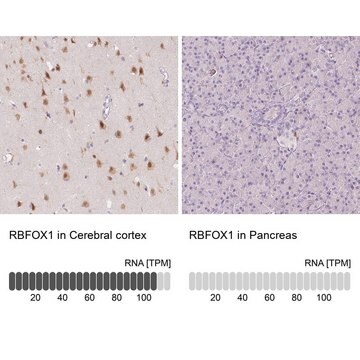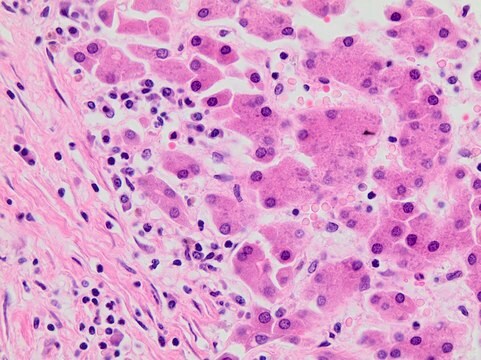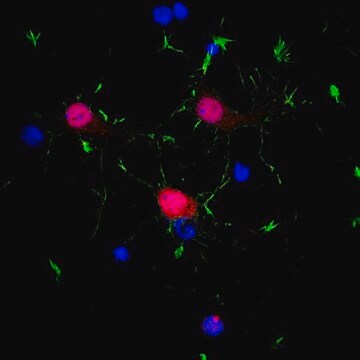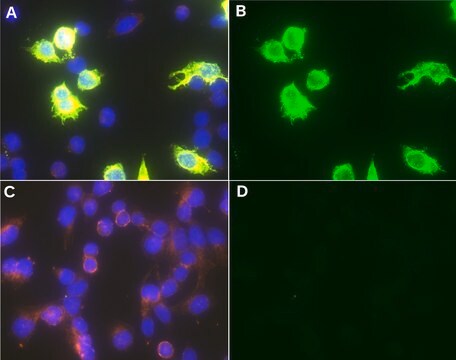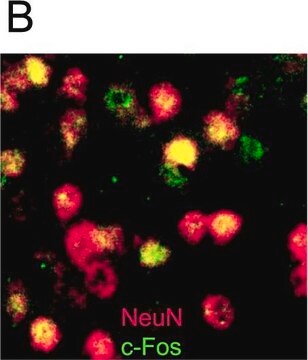MABE985
Anti-Fox1 Antibody, clone 1D10
clone 1D10, from mouse
Synonym(s):
RNA binding protein fox-1 homolog 1, Ataxin-2-binding protein 1, Fox-1 homolog A, Fox1
About This Item
Recommended Products
biological source
mouse
Quality Level
antibody form
purified antibody
antibody product type
primary antibodies
clone
1D10, monoclonal
species reactivity
mouse
technique(s)
RIP: suitable
immunocytochemistry: suitable
immunohistochemistry: suitable
western blot: suitable
isotype
IgG2aκ
NCBI accession no.
UniProt accession no.
shipped in
wet ice
target post-translational modification
unmodified
Gene Information
mouse ... Rbfox3(52897)
General description
Immunogen
Application
Epigenetics & Nuclear Function
Nuclear Receptors
Immunohistochemistry Analysis: A representative lot detected Fox1 in coronal sections from E18 mouse (Tang, Z.Z., et al. (2009). Mol Cell Biol. 29(17):4757-4765).
Immunocytochemistry Analysis: A representative lot detected Fox1 in post-mitotic neuronal cells differentiated from mouse embryonal carcinoma P19 cells (Lee, J.A., et al. (2009). Genes Dev. 23(19):2284-2293).
RNA-Binding Protein Immunoprecipitation/iCLIP Analysis: A representative lot was employed to immunoprecipitate Fox1-associated pre-mRNAs from UV-crosslinked murine cortex homogenates by individual-nucleotide resolution crosslinking immunoprecipitation (iCLIP) for characterization of Fox1 pre-mRNA-binding sites (Gehman, L.T., et al. (2011) Nat Genet. 43(7):706-711).
Western Blotting Analysis: A representative lot detected Fox1 in mouse cortical tissue homogenate (Tang, Z.Z., et al. (2009). Mol Cell Biol. 29(17):4757-4765).
Quality
Western Blotting Analysis: 0.5 µg/mL of this antibody detected Fox1 in 10 µg of adult mouse brain tissue lysate.
Target description
Physical form
Storage and Stability
Other Notes
Disclaimer
Not finding the right product?
Try our Product Selector Tool.
Storage Class Code
12 - Non Combustible Liquids
WGK
WGK 1
Flash Point(F)
Not applicable
Flash Point(C)
Not applicable
Regulatory Listings
Regulatory Listings are mainly provided for chemical products. Only limited information can be provided here for non-chemical products. No entry means none of the components are listed. It is the user’s obligation to ensure the safe and legal use of the product.
JAN Code
MABE985:
Certificates of Analysis (COA)
Search for Certificates of Analysis (COA) by entering the products Lot/Batch Number. Lot and Batch Numbers can be found on a product’s label following the words ‘Lot’ or ‘Batch’.
Already Own This Product?
Find documentation for the products that you have recently purchased in the Document Library.
Our team of scientists has experience in all areas of research including Life Science, Material Science, Chemical Synthesis, Chromatography, Analytical and many others.
Contact Technical Service